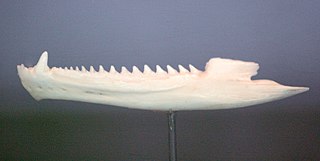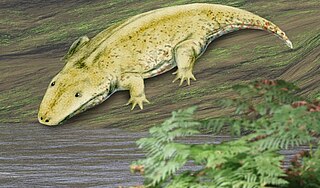
"Labyrinthodontia" is an informal grouping of extinct predatory amphibians which were major components of ecosystems in the late Paleozoic and early Mesozoic eras. Traditionally considered a subclass of the class Amphibia, modern classification systems recognize that labyrinthodonts are not a formal natural group (clade) exclusive of other tetrapods. Instead, they consistute an evolutionary grade, ancestral to living tetrapods such as lissamphibians and amniotes. "Labyrinthodont"-grade vertebrates evolved from lobe-finned fishes in the Devonian, though a formal boundary between fish and amphibian is difficult to define at this point in time.

Temnospondyli is a diverse order of small to giant tetrapods—often considered primitive amphibians—that flourished worldwide during the Carboniferous, Permian, and Triassic periods. A few species continued into the Jurassic and Cretaceous periods. Fossils have been found on every continent. During about 210 million years of evolutionary history, they adapted to a wide range of habitats, including freshwater, terrestrial, and even coastal marine environments. Their life history is well understood, with fossils known from the larval stage, metamorphosis, and maturity. Most temnospondyls were semiaquatic, although some were almost fully terrestrial, returning to the water only to breed. These temnospondyls were some of the first vertebrates fully adapted to life on land. Although temnospondyls are considered amphibians, many had characteristics, such as scales and armour-like bony plates, that distinguish them from modern amphibians (lissamphibians).

Koolasuchus is an extinct genus of brachyopoid temnospondyl in the family Chigutisauridae. Fossils have been found from Victoria, Australia and date back 120 Ma to the Aptian stage of the Early Cretaceous. Koolasuchus is the youngest known temnospondyl. Koolasuchus is known from several fragments of the skull and other bones such as vertebrae, ribs, and pectoral elements. The type species Koolasuchus cleelandi was named in 1997. Koolasuchus cleelandi was adopted as the fossil emblem for the state of Victoria, Australia on 13 January 2022.

Labidosaurus is an extinct genus of reptile from the Permian period of North America. Fossils have been discovered in Texas.
Planocephalosaurus is an extinct genus of rhynchocephalian. Fossils of the genus were found in the Tecovas Formation of Texas and the Magnesian Conglomerate of England.

Mastodonsaurus is an extinct genus of temnospondyl amphibian from the Middle Triassic. It belongs to a Triassic group of temnospondyls called Capitosauria, characterized by their large body size and presumably aquatic lifestyles. Mastodonsaurus remains one of the largest amphibians known, and may have exceeded 6 metres in length.

Metoposaurus meaning "front lizard" is an extinct genus of stereospondyl temnospondyl amphibian, known from the Late Triassic of Germany, Italy, Poland, and Portugal. This mostly aquatic animal possessed small, weak limbs, sharp teeth, and a large, flat head. This highly flattened creature mainly fed on fish, which it captured with its wide jaws lined with needle-like teeth. Metoposaurus was up to 3 m long and weighed about 450 kg. Many Metoposaurus mass graves have been found, probably from creatures that grouped together in drying pools during drought.

Acrodonty is an anatomical placement of the teeth at the summit of the alveolar ridge of the jaw, without sockets, characteristic of bony fish. Functionally, acrodont tooth implantation may be related to strong bite force.

Tasmaniosaurus is an extinct genus of archosauromorph reptile known from the Knocklofty Formation of West Hobart, Tasmania, Australia. The type species is T. triassicus. This genus is notable not only due to being one of the most complete Australian Triassic reptiles known, but also due to being a very close relative of Archosauriformes. Once believed to be a proterosuchid, this taxon is now believed to have been intermediate between advanced non-archosauriform archosauromorphs such as Prolacerta, and basal archosauriforms such as Proterosuchus. Features traditionally used to define Archosauria and later Archosauriformes, such as the presence of an antorbital fenestra and serrated teeth, are now known to have evolved prior to those groups due to their presence in Tasmaniosaurus.

Saharastega is an extinct genus of basal temnospondyl which lived during the Late Permian period, around 251 to 260 million years ago. Remains of Saharastega, discovered by paleontologist Christian A. Sidor at the Moradi Formation in Niger, were described briefly in 2005 and more comprehensively in 2006. The description is based on a skull lacking the lower jaws.

Konzhukovia is an amphibian genus that belongs to an extinct group of temnospondyls, the largest clade of basal tetrapods including about 198 genera, 292 species, and more than half of which were alive during the early Mesozoic period. The animal was a predator that lived about 260 million years ago, and could get up to about 3 meters in length. Specifically, Konzukovia lived during the Permian, between 252 and 270 million years ago according to the type of rock the fossil was found in. There are three species within this genus, K. vetusta, K. tarda, and K. sangabrielensis, the first two originating from Russia while the latest originating from Southern Brazil. The discovery of this specimen in Southern Brazil provided more evidence to support the idea that during this animals existence, there was a “biological corridor” because of the supercontinent Pangea, allowing these species to be found so far apart from each other. Konzhukovia belongs to the family Archegosauridae, a family consisted of large temnospondyls that most likely compare to modern day crocodiles. Since the discovery of the latest species, K. sangabrielensis Pacheco proposes that there must be the creation of a new family, Konzhokoviidae, a monophyletic group in a sister-group relationship with Stereospondlyi in order to accommodate the three species. Konzhukovia skulls usually exhibit typical rhinesuchid features including an overall parabolic shape, small orbits located more posteriorly, and the pterygoids do not reach the vomer. These animals were long-snouted amphibians that had clear adaptations made for fish catching, as well as exemplifying aquatic features.

Brachyopoidea is a superfamily of temnospondyls that lived during the Mesozoic. It contains the families Brachyopidae and Chigutisauridae. The earliest records of brachyopids are from the Lower Triassic in Australia. The latest-surviving member of the superfamily is the chigutisaurid Koolasuchus from the Early Cretaceous of Australia.

Microposaurus is an extinct genus of trematosaurid temnospondyl. Fossils are known from the Cynognathus Assemblage Zone of the Beaufort Group in South Africa and the Rouse Hill Siltstone of Australia that date back to the Anisian stage of the Middle Triassic. These aquatic creatures were the short snouted lineage from Trematosaurinae.
Cargninia is an extinct genus of basal lepidosauromorph from the Late Triassic of Brazil. The type and only known species is Cargninia enigmatica. It is known from the holotype UFRGS PV 1027 T, a partial left dentary found in what is now Faxinal do Soturno, Rio Grande do Sul, southern Brazil, in the geopark Paleorrota. This locality is from the middle section of the Norian-age Caturrita Formation. Cargninia was named by José Fernando Bonaparte, César Leandro Schultz, Marina Bento Soares and Agustín G. Martinelli in 2010. The generic name honors Daniel Cargnin, a Brazilian priest and fossil collector, and the specific name means “enigmatic”, in reference to its uncertain phylogenetic placement.
Libognathus is an extinct genus of procolophonid parareptile from the Late Triassic of Texas. The type and only species, Libognathus sheddi, was named in 1997 from the Cooper Canyon Formation in the fossil-rich Post Quarry, which is found in Garza County. Libognathus was the first definite procolophonid discovered in the southwestern United States, although another possible procolophonid called Chinleogomphius was reported from the southwest before Libognathus was named.
Thecodont dentition is a morphological arrangement in which the base of the tooth is completely enclosed in a deep socket of bone, as seen in crocodilians, dinosaurs and mammals, and opposed to Acrodont and Pleurodont dentition seen in Squamate reptiles. Notably, this appears to be the ancestral tooth condition in Amniota. This morphology was once used as a basis for the now-defunct taxonomic group Thecodontia.

Bunostegos is an extinct genus of pareiasaur parareptile from the Late Permian of the Agadez Region in Niger. The type species, Bunostegos akokanensis, was named from the Moradi Formation in 2003. It was a cow-sized animal with a distinctive skull that had large bony knobs, similar in form to those of other pareiasaurs but far larger. The species appears to have lived in a desert in the centre of the supercontinent of Pangaea.
Bharatagama is an extinct genus of lepidosaur from the Early Jurassic of India. It is has been suggested to be one of the oldest known lizards and the oldest known iguanian. The type and only species is Bharatagama rebbanensis, named in 2002. Over one hundred fossils of Bharatagama have been found in the Kota Formation, which outcrops in the Pranhita–Godavari Basin and dates back to about 190 million years ago (Ma). Despite its abundance, Bharatagama is known only from isolated jaw bones mixed together in microvertebrate assemblages with equally fragmentary remains of fish, sphenodontians, dinosaurs, crocodylomorphs, and mammals. These fossils represent all stages of development, from hatchlings to adults. The total length of the skull in adult specimens is estimated to have been about 15 millimetres (0.59 in). Later analysis suggested that the taxon might be a member of Rhynchocephalia.
Whitakersaurus is a genus of sphenodontid rhynchocephalian reptile dated to be late Triassic in age and is from the Ghost Ranch fossil quarry in New Mexico, USA. It is named after the discoverer of the Ghost Ranch quarry, George O. Whitaker. The fossil was described in 2007.

Polymorphodon is an extinct genus of archosauriform reptile from the Middle Triassic of Germany. The only known species is Polymorphodon adorfi, discovered in Lower Keuper deposits at a quarry in Eschenau, Germany. Polymorphodon is notable for its heterodont dentition, with long and conical premaxillary teeth followed by thin maxillary teeth with large serrations. Maxillary teeth near the back of the mouth are short and leaf-shaped, similar to some living and extinct reptiles with a herbivorous or omnivorous diet. This may suggest that Polymorphodon had some reliance on plants in its diet, a rarity among basal archosauriforms, most of which are carnivores.














